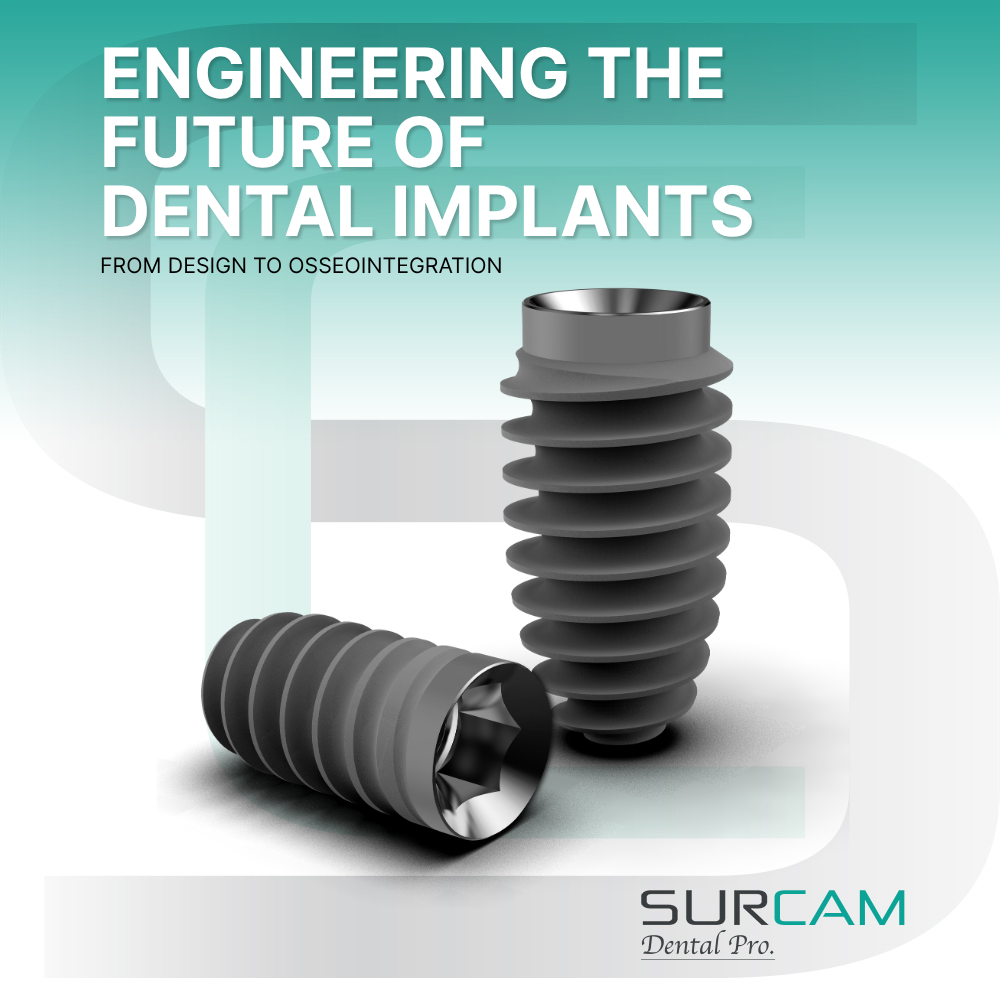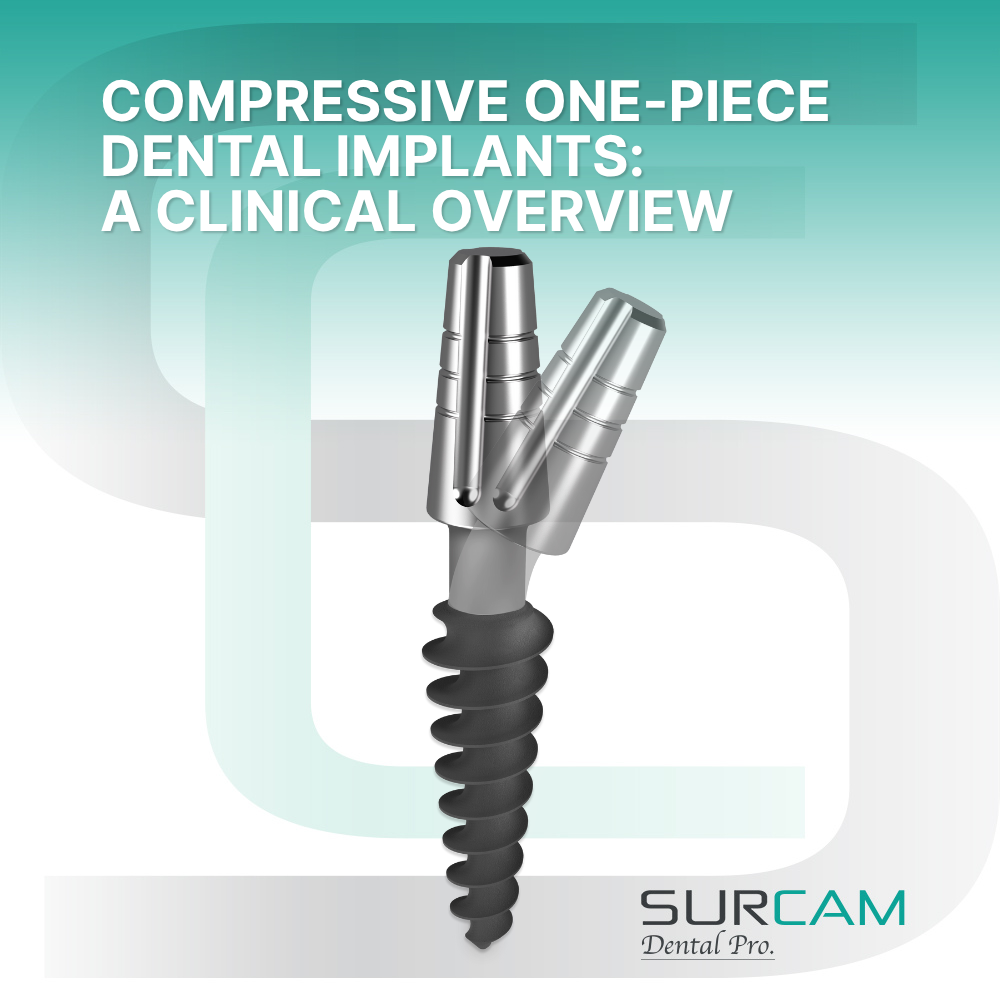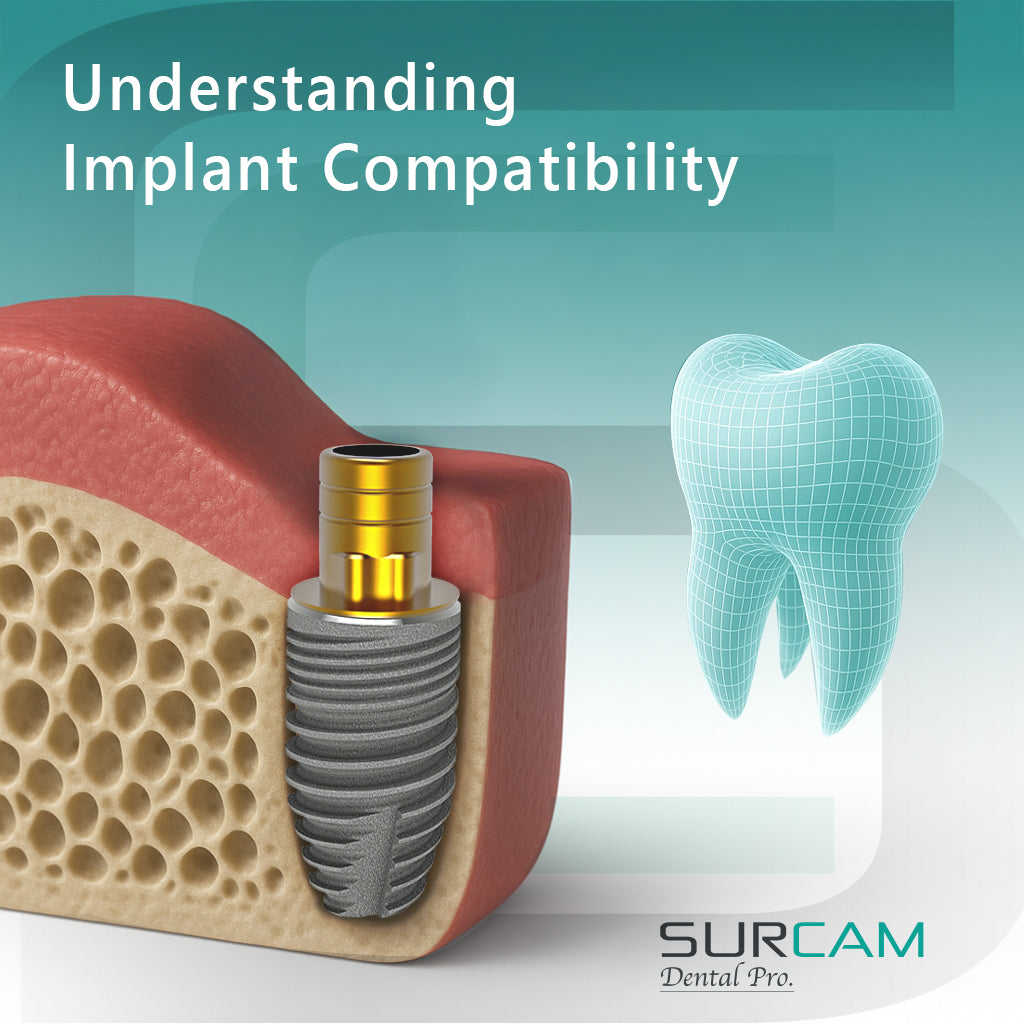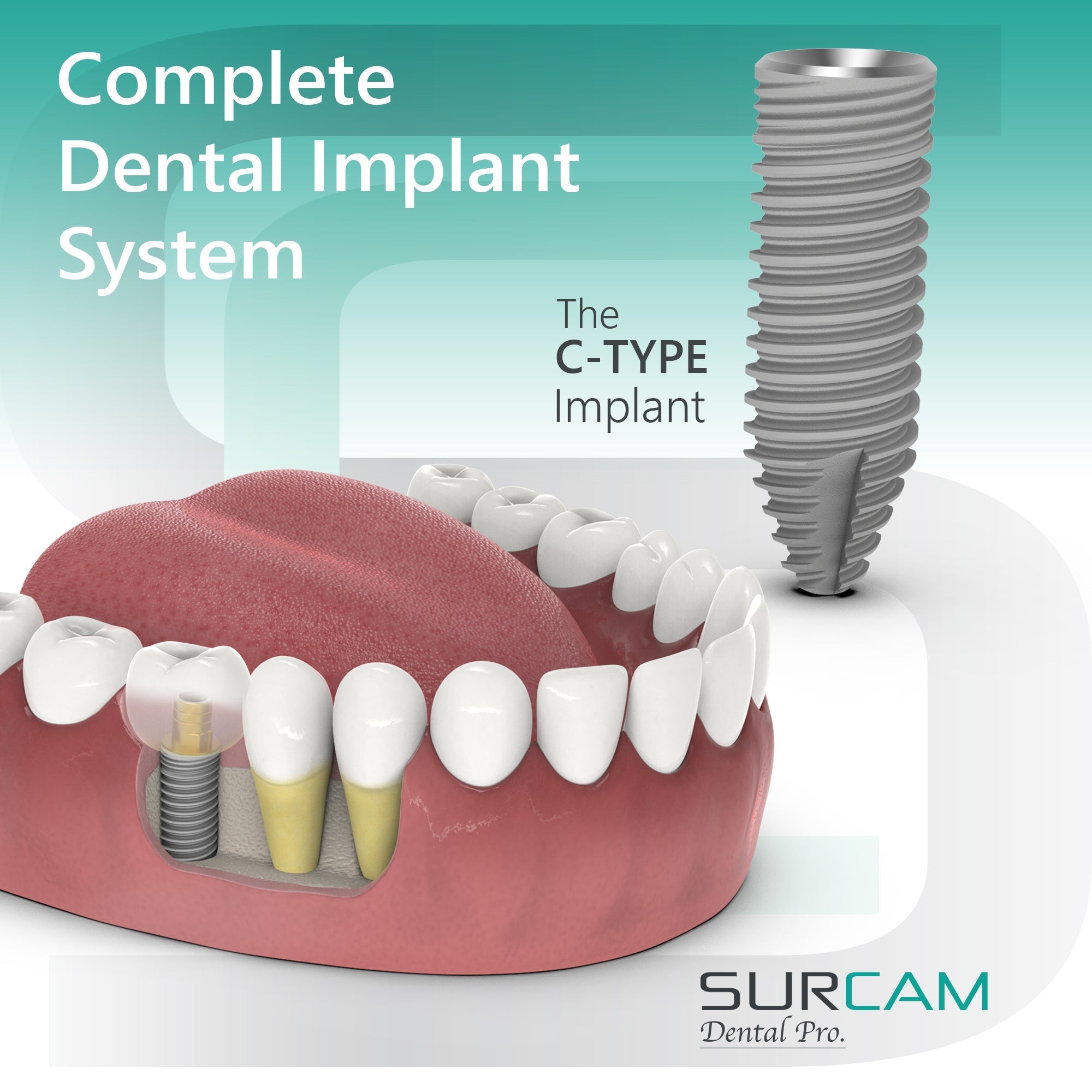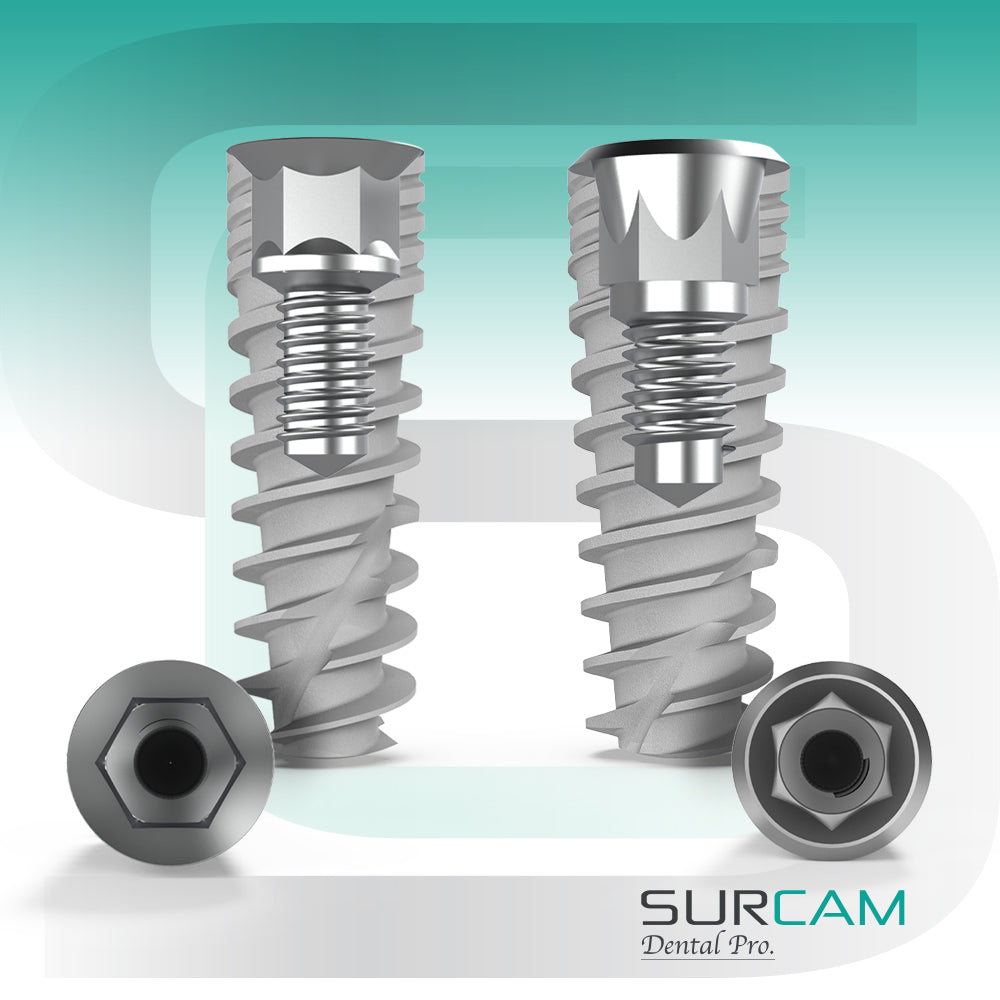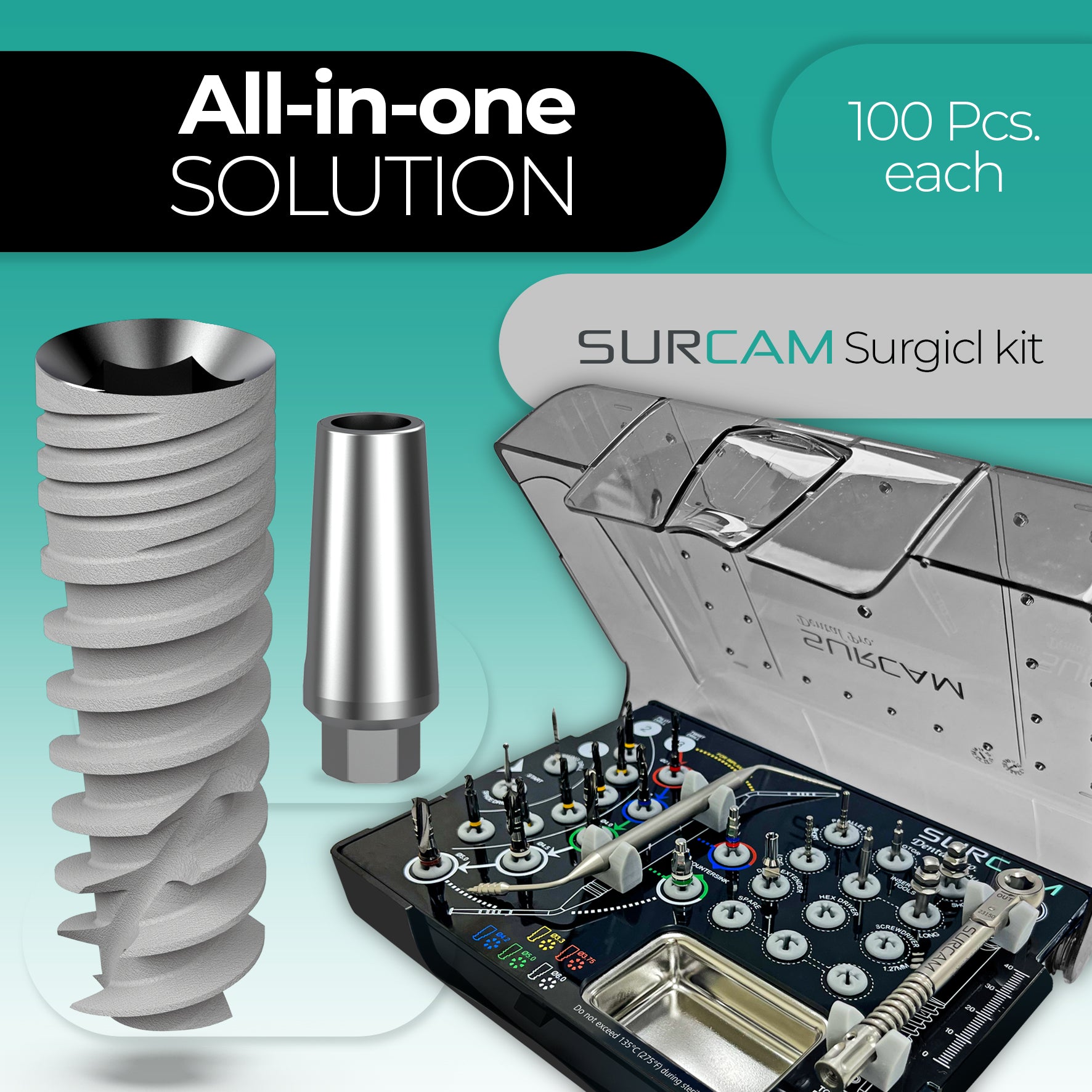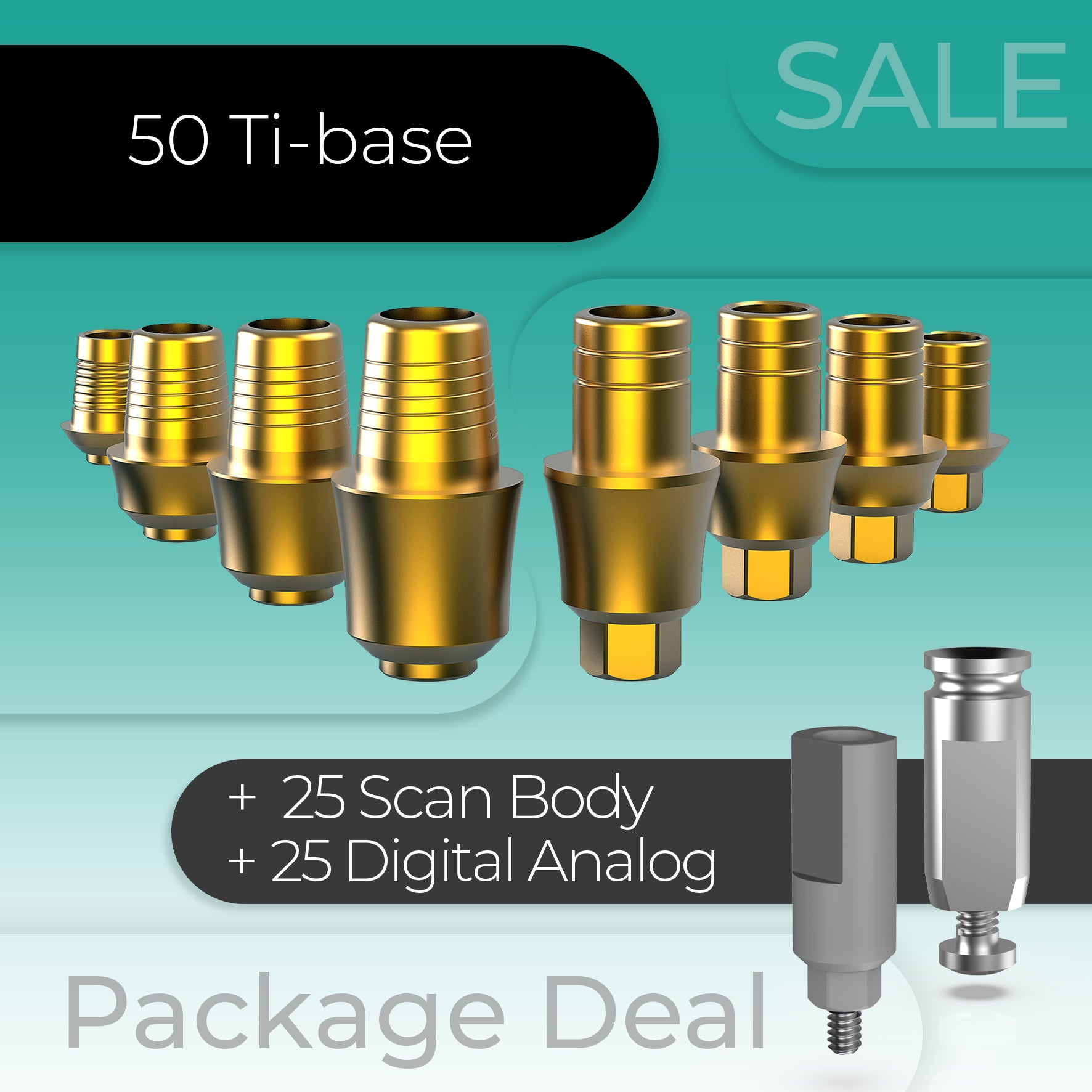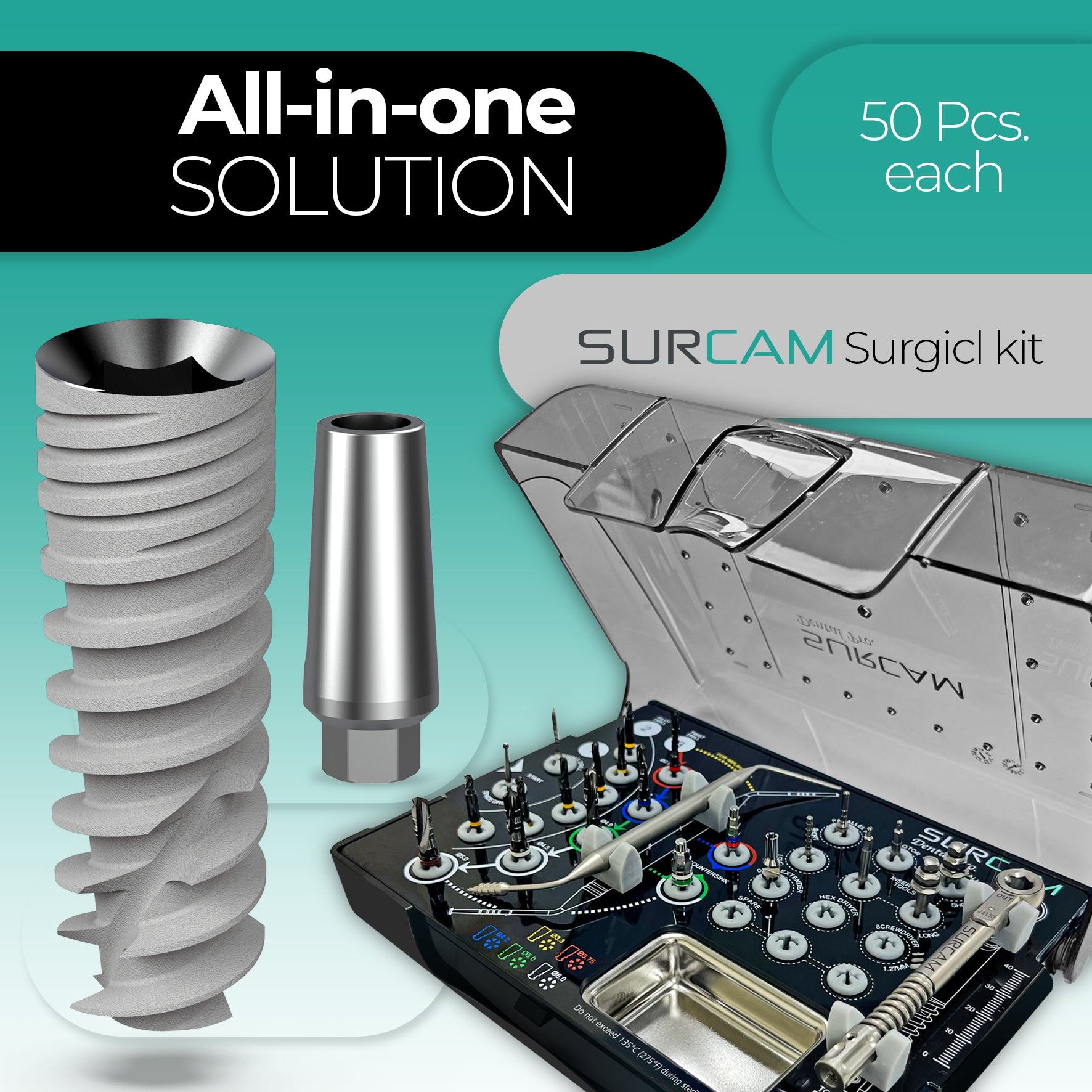Dental Implants The Complete Guide
- by Shay ben shabat
The Manufacturer’s Perspective: A Leading Global Dental Implant Company
Dental implantology is as much about engineering precision as it is about clinical success. At Surcam Dental, we do more than manufacture implants. We engineer biological interfaces that unite materials science, mechanical design, and long-term patient safety. Recognized among the leading global dental implant manufacturers, we combine scientific innovation with advanced production methods to redefine clinical reliability.
Founded in 2002, Surcam Dental Ltd. is an FDA-registered and ISO 13485-certified manufacturer and supplier of premium dental implant systems and prosthetic components. From our production facility in northern Israel, we integrate European-grade CNC machining with advanced surface technology to create dental implants trusted by clinicians, laboratories, and distributors across more than 40 countries. As a global partner in restorative innovation, our mission is to deliver clinically proven systems that set new standards for performance and reliability.
Our focus extends beyond replication. Every thread, torque parameter, and surface finish is refined at the micron level to achieve the highest standard of osseointegration, mechanical stability, and predictable outcomes. Through a vertically integrated production model, from titanium bar sourcing to final sterile packaging, we ensure full traceability and quality control at every stage.
Surcam’s implant families, PRO GRIP (Internal Hex) and PRO SEAL (Conical Connection), are designed for maximum primary stability, restorative versatility, and compatibility with major implant platforms worldwide. These systems reflect our commitment to engineering precision and clinical performance.
Driven by continuous research and development, Surcam Dental has earned recognition among implant system manufacturers, prosthetic innovators, and dental implant suppliers globally.
Surcam stands at the intersection of precision engineering and biological integration, supporting clinicians in achieving stable, esthetic, and long-lasting implant results.
How Dental Implants Work: Engineering Meets Biology & Options for Dental Implants
This section explores how the engineering design of each component directly supports successful clinical outcomes, ensuring reliable integration, restorative precision, and a range of treatment options.
Every successful implant begins long before surgery — it starts in the engineering phase. At Surcam Dental, we design each system to achieve the optimal balance between mechanical stability, surface science, and biological integration.
A dental implant is a precision-engineered device that replaces a missing tooth root with a biocompatible titanium fixture, designed to fuse naturally with the surrounding bone. This process, known as osseointegration, transforms the implant into a permanent, load-bearing part of the jaw.
From a manufacturing perspective, the success of an implant depends on two key factors:
Material Quality: Surcam exclusively uses Grade 5 titanium (Ti-6Al-4V ELI) for its strength, corrosion resistance, and biocompatibility. Each titanium bar is tested for purity and grain structure before CNC machining begins.
Surface Engineering: The implant surface undergoes Surcam’s proprietary SLA (Sandblasted, Large-grit, Acid-etched) treatment, creating a high-energy microtexture that promotes osteoblast attachment and accelerates bone healing.
The geometry of each implant from knife-thread apex to conical platform is modeled using finite element analysis (FEA) to predict stress distribution under masticatory loads. This ensures consistent performance across all bone densities (D1–D4) and supports immediate or early loading protocols when indicated.
Fundamental Parts of a Dental Implant
A dental implant system consists of three fundamental parts:
-
Implant Fixture: The titanium root analogue that transfers functional load to the bone while preserving density and structural integrity.
-
Abutment: A precision-machined connector that creates a stable, sealed interface between the implant and the prosthetic restoration.
-
Crown or Prosthesis: The visible restoration, typically fabricated from zirconia or hybrid ceramics, designed for natural esthetics and long-term durability.
Together, these elements restore full function, appearance, and biomechanical harmony on a precision-engineered foundation that can last for decades.
Each Surcam implant undergoes dimensional verification at every production stage, maintaining ±5 µm accuracy and a surface profile clinically proven to increase bone-to-implant contact by more than 30% compared to untreated titanium.
Components of a Dental Implant System: Full Parts Breakdown
A dental implant system is more than a single fixture, it is a biomechanical assembly engineered for precision, torque control, and seamless integration with soft and hard tissues. At Surcam Dental, every component is designed and tested to perform as part of a unified ecosystem, ensuring full restorative compatibility and mechanical reliability.
Each implant system consists of three interconnected parts: the implant fixture, abutment, and prosthetic connection components. Together, they form the foundation for stable function, esthetics, and long-term bone preservation.
1. Implant Fixture – The Root Analogue
The implant fixture, often referred to as the “body” of the implant, is the load-bearing anchor inserted into the jawbone. Surcam manufactures each fixture from Grade 5 Titanium (Ti-6Al-4V ELI), the same alloy used in aerospace and orthopedic applications for its exceptional strength-to-weight ratio and biocompatibility.
Surcam’s implant bodies feature:
-
Precision CNC-machined threads for uniform bone compression and torque control.
-
Knife-thread apex geometry that enhances primary stability during insertion.
-
Micro-grooved collar to promote soft-tissue attachment and reduce crestal bone loss.
-
SLA surface microstructure, which increases bone-to-implant contact and accelerates healing.
These design parameters ensure mechanical anchorage, even in soft or compromised bone conditions (D3–D4).
2. Abutment – The Prosthetic Connector
The abutment acts as the central link between the implant fixture and the final restorative components. It must maintain a stable and precise connection under dynamic occlusal forces.
Surcam Dental produces both internal hex and conical connection abutments, offering restorative versatility across multiple clinical scenarios.
Key design benefits:
-
Anti-rotation indexing for precise prosthetic alignment.
-
Torque-calibrated screw channels that maintain long-term connection integrity.
-
Tapered sealing design that minimizes micro-gap formation and bacterial infiltration.
-
Available variants: straight, angled, multi-unit, and digital CAD/CAM abutments.
Each abutment is laser-inscribed for traceability and undergoes torque simulation testing to ensure consistent mechanical performance.
3. Prosthetic and Restorative Connection Components
Surcam Dental supports a full spectrum of prosthetic and restorative connection components, including healing abutments, transfer copings, analog models, and CAD/CAM titanium bases compatible with leading digital workflows.
Each component is engineered to deliver accurate prosthetic seating, predictable torque retention, and consistent restorative precision for both traditional and digital implant workflows. The precision of Surcam’s titanium and stainless-steel components ensures optimal load distribution, passive prosthetic fit, and long-term clinical reliability when integrated with laboratory-fabricated crowns or bridges.
Every Surcam Dental component is 3D-modeled, coordinate-measured (CMM-verified), and inspected under ISO 13485 protocols before sterilization and packaging, ensuring unmatched dimensional accuracy and global restorative compatibility.
Why Dental Implants Outperform Other Restorations: Pro and Cons
Dental implants represent the most advanced restorative solution in modern dentistry, offering superior performance, longevity, and precision when compared to traditional bridges or removable dentures. From an engineering standpoint, their advantage lies in their ability to convert biological principles into a mechanical structure that mimics natural tooth function.
Clinical and Engineering Superiority
| Clinical Advantages | Engineering Advantages |
| ✅ Restores full chewing efficiency and natural bite | ✅ Finite element-tested for optimal stress distribution |
| ✅ Prevents bone loss and preserves facial structure | ✅ Precision-machined under ±5 µm tolerance standards |
| ✅ Long-term biological integration and tissue stability | ✅ Anti-rotation and torque-controlled abutment geometry |
| ✅ Enables single, multiple, and full-arch restorations | ✅ Aerospace-grade titanium with superior corrosion resistance |
Unlike traditional restorations, implants do not depend on adjacent teeth for support. This eliminates unnecessary enamel reduction and allows the prosthetic to function independently, maintaining the integrity of the surrounding dentition.
Manufacturer-Level Advantages
At Surcam Dental, performance begins at the design stage. Each implant undergoes multi-stage inspection using CMM (Coordinate Measuring Machine) and FEM (Finite Element Modeling) to predict long-term stress resistance under real-world conditions. The result is a precision-verified implant that maintains torque stability and prevents micro-movement at the abutment interface.
All Surcam implants are manufactured under ISO 13485 and FDA compliance, ensuring consistent quality from raw titanium to sterile packaging. The internal geometry of each system, whether Internal Hex or Conical Connection, is engineered for predictable primary stability across D1–D4 bone types.
Clinical and Patient Benefits
-
Immediate and Lasting Stability: Thread geometry and surface roughness provide instant bone compression and reliable fixation during placement.
-
Accelerated Healing: SLA surface technology encourages faster bone contact and early functional loading.
-
Enhanced Esthetics: The platform’s precision fit minimizes soft-tissue recession and promotes a natural emergence profile.
-
Durability and Value: When properly placed and maintained, implants can perform effectively for 25 years or more (addressing how long do implants last?), often outlasting alternative restorations by decades.
-
Natural Functionality: Once integrated, Surcam implants replicate natural biomechanics, restoring full mastication, phonetics, and comfort.
Designed by engineers and validated by clinicians, every Surcam implant delivers measurable performance: immediate stability, long-term integration, and and confidence that lasts a lifetime.
Comparing Dental Implants and Dentures
Dentures have long served as a basic replacement for missing teeth, but their limitations in comfort, stability, and bone preservation are well documented. In contrast, dental implants represent a complete functional and biomechanical replacement for natural teeth, integrating directly with the jawbone to restore both form and function.
| Criteria | Dental Implants | Conventional Dentures |
| Chewing Power | Restores up to 90% of natural bite force for confident mastication | Limited to about 20%, often restricting diet |
| Bone Health | Stimulates bone through load-bearing osseointegration | Causes bone resorption and jaw shrinkage over time |
| Comfort | Fixed, stable, and personalized to anatomy | Often slips or requires adhesives |
| Speech Clarity | Restores natural articulation | May cause slurring or clicking sounds |
| Hygiene and Maintenance | Simple brushing and flossing | Requires soaking and frequent adjustments |
| Longevity | 25+ years with proper care (Answers how long do implants last?) | Typically replaced every 5–8 years |
| Esthetics | Seamless integration with facial structure | May alter facial contours as bone resorbs |
From a Manufacturer’s Standpoint
Surcam implants are engineered to address every mechanical limitation of removable dentures. Using finite element analysis (FEA) and titanium precision machining, our systems replicate natural occlusal load patterns and maintain bone density.
Dental implants provide a modern, permanent solution that eliminates the mechanical and biological compromises of dentures. For clinicians and patients alike, the difference lies in design: a precision-engineered fixture that becomes part of the body itself.
Types of Dental Implants: Designed for Every Indication
Dental implant designs vary to meet different anatomical and clinical demands. At Surcam Dental, each system is engineered to ensure maximum stability, esthetic harmony, and restorative flexibility, covering all options for dental implants.
Endosteal Implants – The Standard of Modern Implantology
Endosteal implants are the most widely used and clinically validated type. Surcam offers several versatile endosteal options, including the S-Type and A-Type systems. These are manufactured from Grade 5 Titanium (Ti-6Al-4V ELI).
-
Applications: Single-tooth replacements, bridges, and overdentures.
-
Advantages: High osseointegration potential, versatile prosthetic options, and predictable long-term outcomes.
Subperiosteal Implants – Restoring Function When Bone Is Limited
While Surcam primarily focuses on advanced endosteal solutions, the standard C-Type Implant and the C-Type Tissue Level Implant provide stable platforms ideal for challenging bone scenarios.
-
Engineering Highlights: Precision titanium components fabricated via CAD design; Controlled surface porosity for soft-tissue adaptation; Offers stable foundation with minimal surgical invasiveness.
Cortical and Immediate Loading Implants – Strength in Every Density
Surcam’s Cortical and Immediate Loading systems are engineered for high primary stability in dense bone. Key systems include the SC-Type Cortical Implant and the Compressive Dental Implant. They feature deep-cut, self-tapping threads that condense bone during insertion.
-
Advantages: Exceptional primary stability in D1–D4 bone types; Ideal for immediate or early loading; Reduced drilling sequence for faster surgical workflow.
Zygomatic and Pterygoid Implants – Advanced Surgical Solutions
Developed for severe maxillary resorption cases, these long implants provide anchorage in the zygomatic and pterygoid bone. Surcam’s specialized designs include the Zygomatic Dental Implant, the standard Pterygoid Implant, and the Pterygoid Implant with 4mm Neck.
-
Key Features: Long, polished collar and aggressive apex design for stable anchorage; Compatible prosthetic components for digital and conventional restorations; Ideal for graftless rehabilitation and All-on-X procedures.
Surcam Implant Systems for Every Indication
Surcam Dental’s comprehensive portfolio includes:
-
PRO GRIP Internal Hex – A universal solution for traditional implant workflows.
-
PRO SEAL Conical Connection – Enhanced sealing geometry for platform switching and soft-tissue stability.
Every Surcam implant type is validated through fatigue testing, FEM simulation, and clinical collaboration, ensuring precision performance from insertion to restoration.
Surface Technology and Material Science
The surface of a dental implant is one of the most critical factors determining long-term osseointegration and soft-tissue response. At Surcam Dental, every surface treatment is engineered to optimize biological acceptance and enhance the mechanical anchorage between bone and titanium.
SLA Surface – Proven for Rapid Osseointegration
Surcam’s proprietary SLA (Sandblasted, Large-grit, Acid-etched) surface is created through a controlled two-stage process. This dual-level roughness enhances early bone cell activity, shortens healing time, and provides stable osseointegration even under immediate loading protocols.
-
Engineering Benefits: Uniform surface topography verified by scanning electron microscopy (SEM); Enhanced wettability for improved blood clot adhesion and protein interaction; Clinically proven to increase bone-to-implant contact (BIC) by more than 30% compared to machined surfaces.
Prime Series TiN PVD Coating – Aesthetic and Functional Innovation
For clinicians seeking enhanced esthetics and soft-tissue compatibility, Surcam offers its Prime Series TiN (Titanium Nitride) coating. Applied via physical vapor deposition (PVD), this ultra-thin, gold-toned layer provides:
-
Enhanced Gingival Response: Biocompatible coating promotes soft-tissue attachment and stability around abutments.
-
Superior Corrosion Resistance: Protects against micro-oxidation and galvanic wear during long-term use.
-
Reduced Bacterial Adhesion: Smoother coating minimizes plaque accumulation and soft-tissue inflammation.
-
Esthetic Advantage: The warm gold hue reduces gray shine-through under thin gingiva in anterior restorations.
The Prime Series TiN surface treatment is ideal for anterior esthetic zones and soft-tissue management abutments, providing an elegant balance of biological performance and visual harmony.
Material Science and Quality Assurance
Every Surcam implant begins as medical-grade titanium bar stock that undergoes ultrasonic cleaning, vacuum melting, and spectral analysis to confirm material purity. Each production batch is tested for:
-
Microhardness and tensile strength according to ASTM F136 standards.
-
Surface roughness profiling for consistency and reproducibility.
-
Cleanroom-packaged sterilization to maintain surface integrity.
Surface science is not cosmetic, it is the foundation of biological integration. Surcam Dental’s SLA and TiN surfaces are engineered for long-term stability, faster healing, and uncompromising biocompatibility.
Implant Placement: Step-by-Step Clinical Execution
Every stage of implant placement, from digital planning to final restoration, reflects the union of engineering precision and surgical skill, addressing how an implant is inserted. At Surcam Dental, our implant systems are designed for intuitive workflows that minimize chair time while maximizing accuracy, stability, and long-term success.
The clinical process of placing a dental implant and completing the restoration involves three key phases:
Digital Planning and Surgical Preparation:
-
The process begins with 3D diagnostic imaging (CBCT) and digital simulation to evaluate bone volume, angulation, and soft-tissue contours.
-
Surcam systems are compatible with guided surgery platforms, enabling precise preoperative positioning and restorative planning.
-
Custom drill sequences, matched to the implant diameter and bone density, are prepared for controlled insertion torque.
Surgical Execution and Primary Stability:
-
Osteotomy preparation is completed using the prescribed drill sequence.
-
The implant fixture is inserted under controlled, calibrated torque, ensuring optimal primary stability.
-
The SLA surface immediately promotes blood clot adhesion and bone cell colonization, initiating osseointegration.
-
Immediate or early loading protocols may be initiated based on the achieved insertion torque and bone quality.
Restorative Phase and Prosthetic Connection:
-
After the healing period (osseointegration), the implant is uncovered and the healing abutment is placed.
-
An impression (conventional or digital scan) is taken to capture the implant position.
-
A precision-machined abutment (straight, angled, or multi-unit) is attached, guaranteeing a stable interface.
-
The final prosthetic restoration, typically a crown or bridge, is seated, completing the functional and esthetic rehabilitation.
Surcam’s implant design eliminates guesswork: engineered insertion torque, defined drill sequences, and precision-thread geometry ensure consistency across every surgical and prosthetic step.
Longevity, Maintenance, and Clinical Outcomes
The longevity of a dental implant depends on two interconnected elements: engineering integrity and patient maintenance, answering: how long do implants last?
Engineering for Durability
Surcam implants undergo extensive mechanical and biological testing before market release. Using Finite Element Analysis (FEA) and dynamic fatigue testing, we evaluate how implants perform under long-term occlusal loading and biological stress.
Key Metrics:
-
Cyclic loading simulations replicating 20+ years of function.
-
Torque retention analysis ensuring secure abutment fixation.
-
Micro-gap and micro-motion assessments for bacterial sealing efficiency.
Maintenance Protocol for Clinicians and Patients
Proper maintenance extends the clinical life of the implant and surrounding soft tissue.
Recommended Care:
-
Brush and floss daily using implant-safe instruments and non-abrasive toothpaste.
-
Employ soft interdental brushes or water flossers for subgingival cleaning.
-
Schedule clinical follow-ups every 6–12 months to monitor peri-implant health.
-
Perform radiographs annually to evaluate bone levels and prosthetic fit.
-
Re-check abutment torque values and screw preload at every maintenance visit.
Clinicians should educate patients on peri-implant disease prevention, emphasizing hygiene compliance and periodic evaluation. Surcam’s precision-fit connections minimize bacterial leakage, reducing the risk of inflammation and bone loss.
Expected Lifespan and Clinical Outcomes
Surcam implants are built to last. With proper care, their titanium structure can remain functional for 25 years or more, often lasting a lifetime. Prosthetic restorations may require replacement after 10–15 years depending on wear and occlusal forces.
True implant longevity is the result of engineering precision, surface innovation, and continuous clinical monitoring, all core values of Surcam Dental’s manufacturing philosophy.
Global Leadership in Dental Implant Manufacturing
For over two decades, Surcam Dental has set new benchmarks in precision manufacturing and restorative innovation. As an ISO 13485-certified and FDA-registered dental implant manufacturer, we uphold global standards of quality, safety, and reliability, combining scientific research with advanced machining technology.
Engineering Leadership and Innovation
Surcam’s engineering philosophy is grounded in accuracy, material purity, and clinical performance. Our vertically integrated production model manages every stage: from titanium sourcing and CNC milling to passivation, cleaning, and final sterile packaging. This ensures that every implant is traceable, torque-verified, and ready for immediate clinical use.
Manufacturing Capabilities:
-
CNC Multi-Axis Machining: Micron-level accuracy across all implant geometries.
-
Automated Surface Treatment: SLA and TiN coating performed under cleanroom conditions.
-
Quality Assurance Laboratories: In-house metrology (CMM, SEM) and mechanical fatigue testing.
-
Digital Workflow Integration: Fully compatible with CAD/CAM systems for restorative accuracy.
Global Presence and Distribution
Surcam Dental’s headquarters and production facilities are located in northern Israel, strategically positioned for international distribution. Our implants and prosthetic components are exported to dental clinics, laboratories, and distributors across North America, Europe, Asia, and the Middle East.
We collaborate with universities, dental associations, and key opinion leaders worldwide to advance implantology through education, research, and innovation.
Why Choose Surcam Dental
-
Fully traceable production - from raw titanium sourcing to sterile packaging.
-
FDA-cleared and CE-marked systems - ensuring uncompromising global compliance.
-
Digital and conventional compatibility - engineered for every restorative workflow.
-
Worldwide clinical support - trusted by dentists, labs, and distributors across 40+ countries.
-
Fast logistics and responsive technical service - because precision deserves reliability.
For over two decades, Surcam Dental has proven that precision is not just a standard it is a promise. Every implant we manufacture carries the same purpose: to restore confidence, function, and the human connection at the heart of modern implantology.
- Posted in:
- Dental Implant
- Educational







